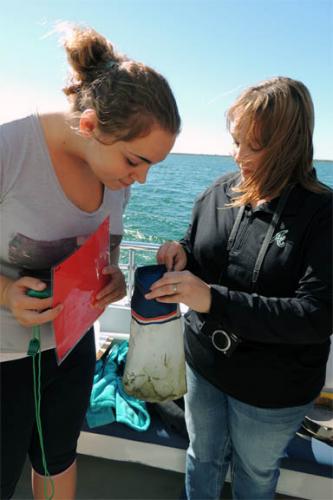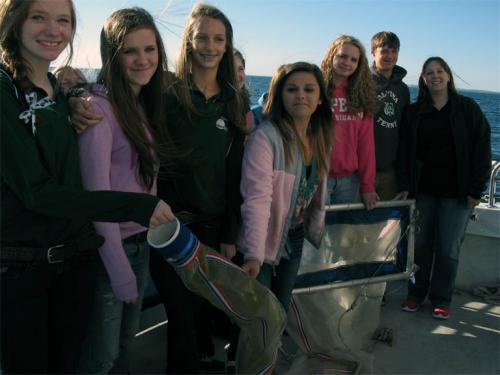Alpena students apply chemistry to study of plastic pollution in northern Lake Huron
Alpena High students test their chemistry skills in researching plastic pollution in the Great Lakes, while gathering data, raising awareness, and exploring possible solutions toward this issue of pollution.
Marine debris (or floating litter) is a growing issue and concern in our world’s oceans, but also here at home in our freshwater seas -- the Great Lakes. Plastic pollution was the focus of a recent research expedition led by Alpena High School ninth grade chemistry students who set out to explore this very issue in northern Lake Huron.
This opportunity to investigate plastic pollution in the Great Lakes was developed by their teacher, Melissa Smith, during her participation in the 2013 Lake Huron Summer Place-Based Education Institute. Engaging her class in this emerging issue reflects a place-based education opportunity where students are learning about marine debris and microplastics, as well as why they are of concern in the Great Lakes.
This project is also a chance to learn about careers in chemistry. Students are coordinating and sharing their data with Dr. Sherri Mason, a chemistry professor at Fredonia State University in New York, 
During a research cruise onto Lake Huron, students collected water samples aboard the Glass bottom boat Lady Michigan by deploying a surface trawl, a research net designed to sample plastic pollution. Collecting data specific to local Thunder Bay waters, these samples were taken back to the school chemistry lab where they were analyzed for plastics and other chemicals. While on the water, students conducted some field-based water chemistry analysis and learned about biological pollution – aquatic invasive species – also affecting the health of Lake Huron ecosystems.
Only one week earlier, students conducted a litter pick-up along a local Alpena beach participating as part of the Great Lakes Adopt-a-Beach Program, partnering with Alliance for the Great Lakes. Their goal was to gain a hands-on understanding of the issue of marine debris affecting their local coastal community. They identified several types and sources plastic pollution and were able to compare local debris findings with data reported from across the Great Lakes.
Prior to these field studies, students researched this issue in class, learning first about marine debris, such as the widely publicized Pacific Ocean ‘garbage patch’. The class next localized the issue by exploring current scientific research about plastic pollution in the Great Lakes, including studies about microplastic beads tha
In the lab, students conducted a preliminary assessment of their own local Lake Huron samples, which will be shared and verified with Dr. Mason’s research team. Students sorted their samples under microscopes discovering relatively low amounts but a variety of plastic pollution. They found blue plastic fibers they believed to be from nylon roping or blue plastic tarps, along with some brightly colored red, green, and blue particles they thought possibly from shopping bags and plastic wrapping. The class even found a few perfectly round green and blue plastic particles thought to be microplastic beads from personal care products.
Working with Great Lakes scientists, these students are contributing scientific information about plastic pollution in Lake Huron, while raising awareness about marine debris in their local watershed. As the class continues its studies, they hope to be more involved in addressing the issue of plastics entering the Great Lakes, and developing a plan to prevent marine debris. They hope to educate and involve their community as partners in exploring ways to reduce and prevent plastic debris from entering the waterways.
You can learn more about the issue of marine debris at the NOAA Marine Debris Program website. Visit the NE MI GLSI website to learn more about the Northeast Michigan Great Lakes Stewardship Initiative, NOAA B-WET water education efforts, and this place-based education partnership with Alpena High School.



 Print
Print Email
Email




